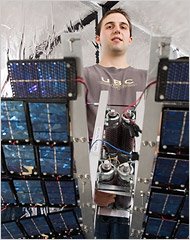NY Times Talks NASA Centennial Challenges

The NY Times has an excellent article on NASA's foray into the Grand Challenge model of research and development. Instead of paying millions to contractors to develop new technologies, why not sponsor contests and only pay the winners? Folks have fun and NASA gets tons of cheap R&D.
[T]he agency is offering 13 contests, which it calls Centennial Challenges, that anyone can enter. The prizes range from $200,000 to more than $5 million, for building gear as diverse as solar sails, lunar excavators and the tiny elevators.
The article talks a good bit about the Beam Power Challenge, a competition to build a robot that will climb a ribbon 200 ft into the air as quick as possible. The end goal is to create a space elevator. NASA also has a competition to build the strongest ribbon possible, to further foster development.
You can see the full list of challenges on NASA's website.
"Look, a hundred years ago, a couple of pesky bike mechanics from Dayton, Ohio, bested, in effect, the government-funded player, to become the first to fly," he added. "That's why you put on these things: to attract the bicycle mechanics."

0 Comments:
Post a Comment
<< Home